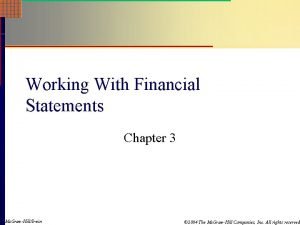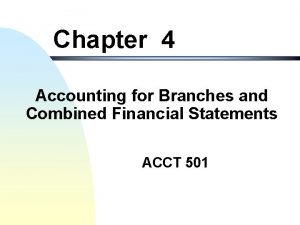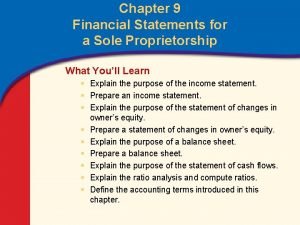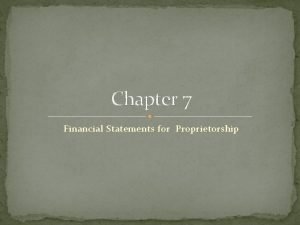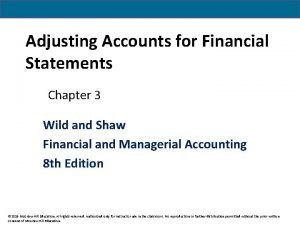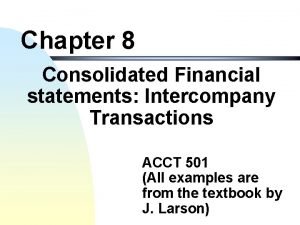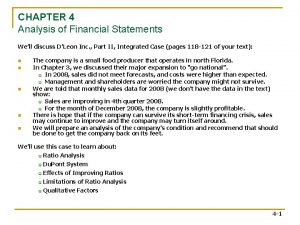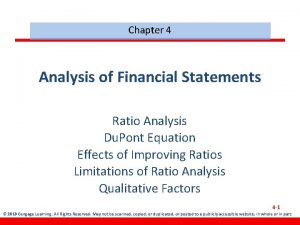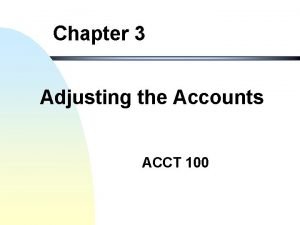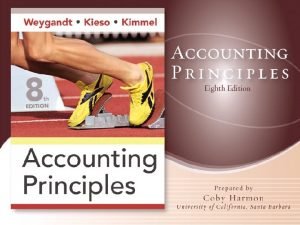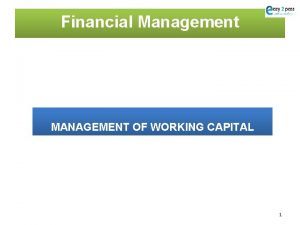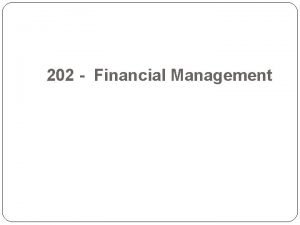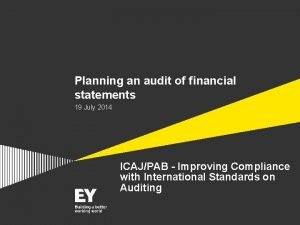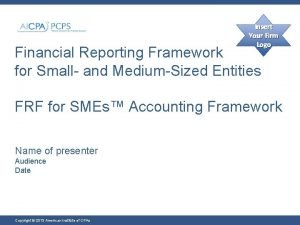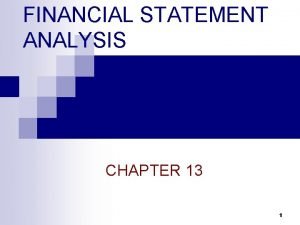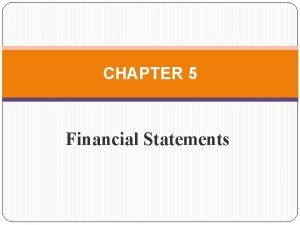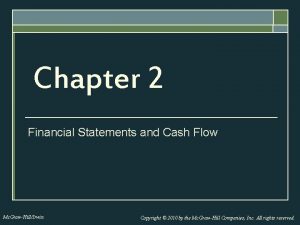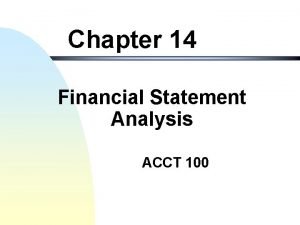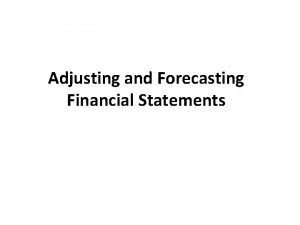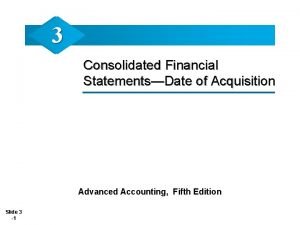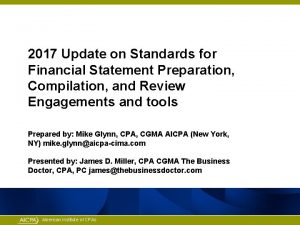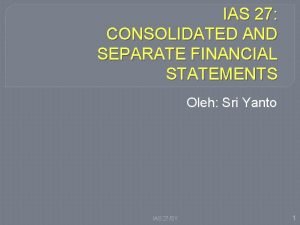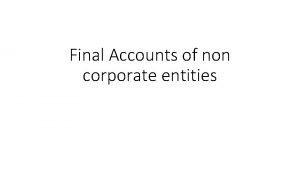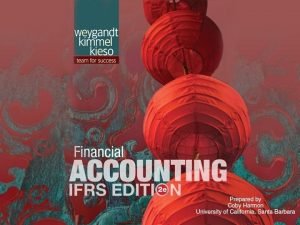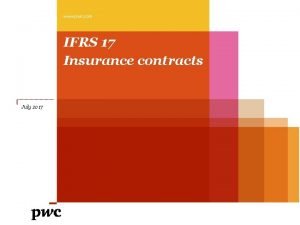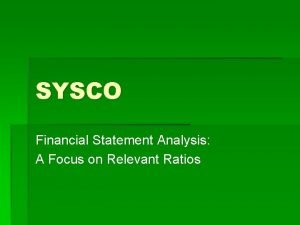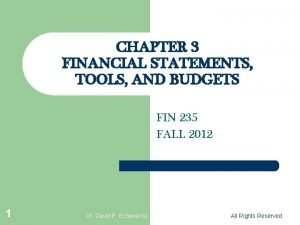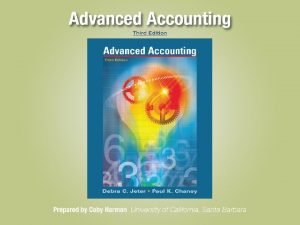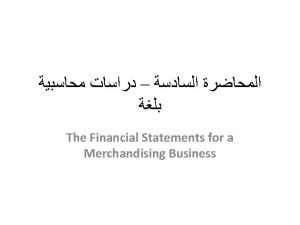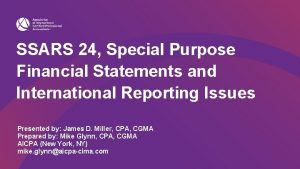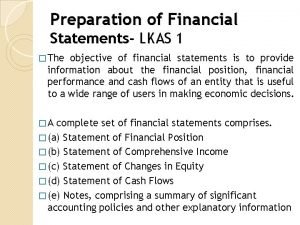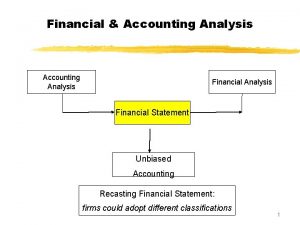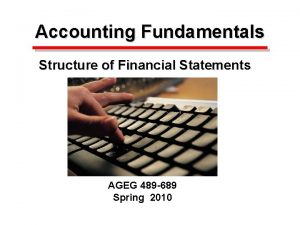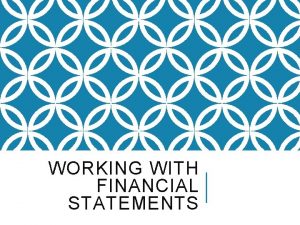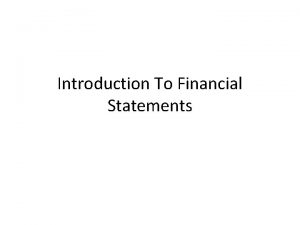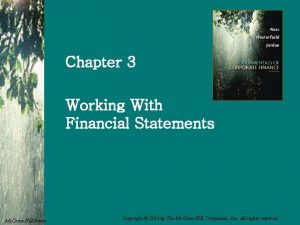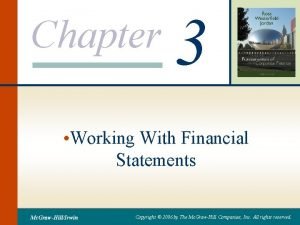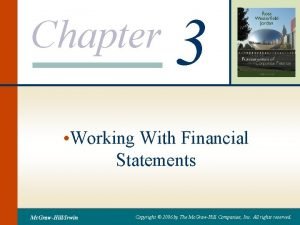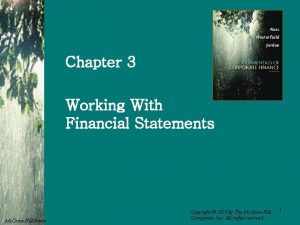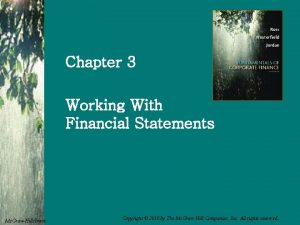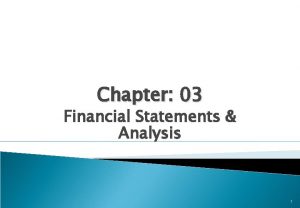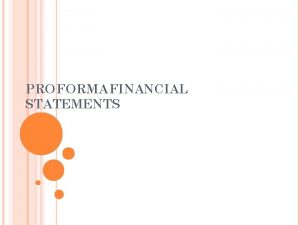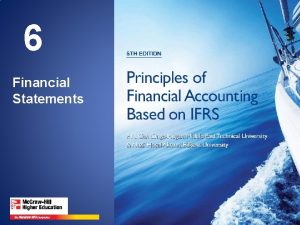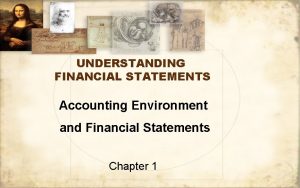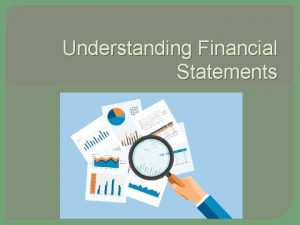Chapter 3 Working with Financial Statements Mc GrawHillIrwin


















































- Slides: 50

Chapter 3 • Working with Financial Statements Mc. Graw-Hill/Irwin Copyright © 2006 by The Mc. Graw-Hill Companies, Inc. All rights reserved.

Chapter 3 – Index of Sample Problems • • Slide # 02 - 06 Slide # 07 - 08 Slide # 09 - 12 Slide # 13 - 18 Slide # 19 - 26 Slide # 27 - 33 Slide # 34 - 46 Slide # 47 - 48 Sources and uses of cash Cash flow categories Common-size statements Liquidity ratios Long-term solvency ratios Asset utilization ratios Profitability ratios, including Du. Pont Market value ratios

2: Sources and uses of cash Complete the table by indicating which accounts are a source of cash and which are a use of cash. The next slide provides the answers. 2005 2004 $ 18, 900 $ 17, 300 Accounts receivable 12, 350 13, 480 Inventory 76, 200 75, 400 425, 000 452, 000 26, 800 28, 500 Long-term debt 195, 600 230, 900 Common stock 220, 000 210, 000 90, 050 88, 780 Cash Net fixed assets Accounts payable Retained earnings Source/Use U

3: Sources and uses of cash The asset accounts are shown in light yellow. The liability and equity accounts are in light blue. Source/Use 2005 2004 $ 18, 900 $ 17, 300 U Accounts receivable 12, 350 13, 480 S Inventory 76, 200 75, 400 U 425, 000 452, 000 S 26, 800 28, 500 U Long-term debt 195, 600 230, 900 U Common stock 220, 000 210, 000 S 90, 050 88, 780 S Cash Net fixed assets Accounts payable Retained earnings

4: Sources and uses of cash Balance Sheet Liabilities and Asset Cash Increase Decrease Use Source Equity Increase Decrease Source Use Cash

5: Sources and uses of cash What is the amount of each source and use of cash? Source/Use 2005 2004 $ 12, 350 $ 13, 480 S Net fixed assets 425, 000 452, 000 S Common stock 220, 000 210, 000 S 90, 050 88, 780 S Accounts receivable Retained earnings Cash $ 18, 900 $ 17, 300 U Inventory 76, 200 75, 400 U Accounts payable 26, 800 28, 500 U 195, 600 230, 900 U Long-term debt Amount of source or use $ 1, 130 Total: $39, 400 The asset accounts are shown in yellow. The liability and equity accounts are in blue.

6: Sources and uses of cash The sources of cash must equal the uses of cash. Source/Use Amount of source/use 2005 2004 $ 12, 350 $ 13, 480 S 1, 130 Net fixed assets 425, 000 452, 000 S 27, 000 Common stock 220, 000 210, 000 S 10, 000 90, 050 88, 780 S 1, 270 Accounts receivable Retained earnings Total: Cash $39, 400 $ 18, 900 $ 17, 300 U $ 1, 600 Inventory 76, 200 75, 400 U 800 Accounts payable 26, 800 28, 500 U 1, 700 195, 600 230, 900 U 35, 300 Long-term debt Total: $39, 400

7: Cash flow categories For each of the following accounts, identify whether they are an operating activity (O), an investment activity (I), or a financing activity (F). Accounts payable O, I, or F O Account Cash Accounts receivable Dividends paid Long-term debt Retained earnings Net income Interest paid Inventory Paid in surplus Common stock Sales O, I, or F

8: Cash flow categories Financing = Long-term debt, equity, interest paid and dividends Investing = Long-term assets Operating = Current assets, current liabilities and income statement accounts, excluding interest paid Account O, I, or F Accounts payable O Cash O Accounts receivable O Dividends paid F Long-term debt F Retained earnings F Net income O Interest paid F Inventory O Paid in surplus F Common stock F Fixed assets I

9: Common-size statements Complete the table by inserting the common-size ratios. Round all numbers to the nearest 1/10 of a percent. Assets Cash Liabilities and equity $ 1, 200 4. 9% Accounts payable $1, 700 Accounts receivable 2, 600 Long-term debt 9, 800 Inventory 4, 900 Common stock 10, 000 Net fixed assets Total assets 15, 600 Retained earnings $24, 300 100. 0% Total liabilities and equity 2, 800 $24, 300

10: Common-size statements Total assets is set equal to 100%. All other accounts are expressed as a percentage of total assets. Assets Cash Liabilities and equity $ 1, 200 4. 9% Accounts payable $1, 700 7. 0% Accounts receivable 2, 600 10. 7% Long-term debt 9, 800 40. 3% Inventory 4, 900 20. 2% Common stock 10, 000 41. 2% Net fixed assets Total assets 15, 600 $24, 300 64. 2% Retained earnings 100. 0% Total liabilities and equity 2, 800 11. 5% $24, 300 100. 0 %

11: Common-size statements Complete the table by inserting the common-size ratios. Income Statement Sales $124, 500 Costs of goods sold 87, 500 Other costs 21, 800 Depreciation 8, 400 Interest 2, 100 Taxes Net income 750 $ 3, 950 100%

12: Common-size statements Sales is expressed as 100%. All other accounts are expressed as a percentage of sales. Income Statement Sales $124, 500 100. 0% Costs of goods sold 87, 500 70. 3% Other costs 21, 800 17. 5% Depreciation 8, 400 6. 7% Interest 2, 100 1. 7% 750 0. 6% $ 3, 950 3. 2% Taxes Net income

13: Liquidity ratios Use this information to calculate the ratios below. Cash $ 900 Accounts receivable 1, 200 Inventory 2, 100 Accounts payable 1, 600 Average daily operating costs 70 Total assets 8, 600 Current ratio = _____ Cash ratio = _____ Quick ratio = _____ Interval measure = _____ Net working capital to total assets = _____

14: Liquidity ratios Cash Accounts receivable 1, 200 Inventory 2, 100 Current assets $ 900 Accounts payable Current liabilities 1, 600 $4, 200 Answers continued on next slide.

15: Liquidity ratios Cash Accounts receivable Inventory Accounts payable Average daily operating costs Total assets $ 900 $1, 200 $2, 100 $1, 600 $ 70 $8, 600

16: Liquidity ratios Assume you start with this situation: Cash $100 Accounts receivable 100 Inventory 100 Total current assets Accounts payable $150 Total current liabilities $300 $150 Now assume you pay $50 on your accounts payable. You now have this situation. Cash $ 50 Accounts receivable 100 Inventory 100 Total current assets Accounts payable $100 Total current liabilities $250 $100

17: Liquidity ratios Indicate for each action whether the current ratio, the quick ratio and the cash ratio will increase (I), decrease (D) or not change (NC). Assume net working capital is positive. 1. Short-term debt is paid 2. Long-term debt is paid 3. Inventory is sold on credit at a profit 4. Inventory is sold for cash at cost 5. A customer pays their bill 6. Inventory is purchased on accounts payable 7. Inventory is purchased for cash 8. Cash is received from long-term loan Current ______ ______ Quick ______ ______ Cash _____ ______ ______

18: Liquidity ratios Current 1. Short-term debt is paid I 2. Long-term debt is paid D 3. Inventory is sold on credit at a profit I NC 4. Inventory is sold for cash at cost NC 5. A customer pays their bill NC 6. Inventory is purchased on accounts payable D 7. Inventory is purchased for cash NC 8. Cash is received from long-term loan I Quick I D I Cash I D I NC I I D D I

19: Long-term solvency ratios Total assets Long-term debt Total equity EBIT (Earnings Before Interest and Taxes) Interest Depreciation

20: Long-term solvency ratios Your firm has total assets of $146, 000 and a total debt ratio of 40%. What is the firm’s debt-equity ratio?

21: Long-term solvency ratios Your firm has total assets of $146, 000 and a total debt ratio of 40%. What is the firm’s debt-equity ratio? Step 1: Find total debt Step 2: Find total equity Step 3: Find debt-equity ratio

22: Long-term solvency ratios Your firm has long-term debt of $63, 000. The long-term debt ratio is. 40 and the equity multiplier is 1. 8. What is the amount of total assets? Try this. If you get stuck, proceed to the next slide for a hint.

23: Long-term solvency ratios Your firm has long-term debt of $63, 000. The long-term debt ratio is. 40 and the equity multiplier is 1. 8. What is the amount of total assets? Hint: By using the equity multiplier you can determine the amount of total assets. But, you will need to know the amount of total equity. Total equity can be found by using the longterm debt ratio.

24: Long-term solvency ratios Your firm has long-term debt of $63, 000. The long-term debt ratio is. 40 and the equity multiplier is 1. 8. What is the amount of total assets? Step 1: Find total equity Step 2: Find total assets

25: Long-term solvency ratios Your firm has earnings before interest and taxes of $27, 931. The times interest earned ratio is 5. 3 and the cash coverage ratio is 8. 6. What is the amount of the interest paid expense? What is the amount of the depreciation expense?

26: Long-term solvency ratios Your firm has earnings before interest and taxes of $27, 931. The times interest earned ratio is 5. 3 and the cash coverage ratio is 8. 6. Step 1: Find the interest expense using the times interest earned ratio Step 2: Find the depreciation expense using the cash coverage ratio

27: Asset utilization ratios Sales and accounts receivables are valued at the retail selling price. Cost of goods sold, inventory and accounts payable are valued at the wholesale purchase price. When computing turnover rates, you match retail prices with retail prices. You match wholesale prices with wholesale prices as seen in the formulas. Retail Prices Wholesale Prices

28: Asset utilization ratios Your firm has sales of $927, 450, accounts receivables of $34, 350, inventory of $48, 600 and costs of goods sold of $648, 810. What is the inventory turnover rate? How many days does it take to sell inventory? What is the accounts receivable turnover rate? How many days does it take to collect payment from a customer? Round your answers to two decimal places.

29: Asset utilization ratios Your firm has sales of $927, 450, accounts receivables of $34, 350, inventory of $48, 600 and costs of goods sold of $648, 810.

30: Asset utilization ratios Your firm has current liabilities of $21, 800, total assets of $82, 900 and sales of $149, 200. The net working capital is $4, 600. What is the NWC turnover rate? What is the fixed asset turnover rate? Round the turnover rates to two decimal places.

31: Asset utilization ratios Your firm has current liabilities of $21, 800, total assets of $82, 900 and sales of $149, 200. The net working capital is $4, 600.

32: Asset utilization ratios Your firm has current liabilities of $21, 800, total assets of $82, 900 and sales of $149, 200. The net working capital is $4, 600. What is the total asset turnover rate? Round the turnover rate to two decimal places.

33: Asset utilization ratios Your firm has current liabilities of $21, 800, total assets of $82, 900 and sales of $149, 200. The net working capital is $4, 600.

34: Profitability ratios Your firm has net income of $123, 000 on sales of $2. 4 million. Total assets are $2. 46 million and total equity is $1. 5 million. What is the profit margin? What is the return on assets? What is the return on equity?

35: Profitability ratios Your firm has net income of $123, 000 on sales of $2. 4 million. Total assets are $2. 46 million and total equity is $1. 5 million.

36: Profitability ratios Your firm has net income of $368, 400, total assets of $23. 946 million and an equity multiplier of 1. 6. What is the return on equity?

37: Profitability ratios Your firm has net income of $368, 400, total assets of $23. 946 million and an equity multiplier of 1. 6. What is the return on equity? Step 1: Find total equity (TE) Step 2: Find return on equity (ROE)

38: Profitability ratios A firm has net income of $368, 400, total assets of $23. 946 million and an equity multiplier of 1. 6. What is the return on equity? Step 1. Compute ROA Step 2. Compute ROE

39: Profitability ratios What is the Du. Pont formula? What is each part of the Du. Pont formula called? Why use the Du. Pont formula?

40: Profitability ratios What is the Du. Pont formula? What is each part of the Du. Pont formula called? Why use the Du. Pont formula? (listen for this answer)

41: Profitability ratios Your firm has sales of $324, 000 and total assets of $216, 000. The debt-equity ratio is. 5 and the profit margin is 5. 4%. What are the values of the three parts of the Du. Pont formula? What is the ROE? Try to solve this problem before proceeding. If you get stuck, the next slide provides some hints.

42: Profitability ratios Your firm has sales of $324, 000 and total assets of $216, 000. The debt-equity ratio is. 5 and the profit margin is 5. 4%. What are the values of the three parts of the Du. Pont formula? What is the ROE? Hint: Step 1: Solve for total equity using the debt-equity ratio and this formula: TA = TD + TE

43: Profitability ratios Your firm has sales of $324, 000 and total assets of $216, 000. The debt-equity ratio is. 5 and the profit margin is 5. 4%. What are the values of the three parts of the Du. Pont formula? What is the ROE?

44: Profitability ratios Your firm has sales of $12, 600, total assets of $8, 100, and a debtequity ratio of. 80. The return on equity is 14%. What is the net income? Try to solve this by yourself. If you can’t, then see the hint on the next slide.

45: Profitability ratios Your firm has sales of $12, 600, total assets of $8, 100, and a debt-equity ratio of. 80. The return on equity is 14%. What is the net income? Here are some formula hints.

46: Profitability ratios Your firm has sales of $12, 600, total assets of $8, 100, and a debt-equity ratio of. 80. The return on equity is 14%. What is the net income?

47: Market value ratios A firm has net income of $638, 000 and total equity of $3. 828 million. There are 200, 000 shares of common stock outstanding. Each share is currently selling for $76. 56. What is the P/E ratio? What is the market-to-book ratio?

48: Market value ratios A firm has net income of $638, 000 and total equity of $3. 828 million. There are 200, 000 shares of common stock outstanding. Each share is currently selling for $76. 56.

Chapter 3 • End of Chapter 3 Mc. Graw-Hill/Irwin Copyright © 2006 by The Mc. Graw-Hill Companies, Inc. All rights reserved.
 Working with financial statements chapter 3
Working with financial statements chapter 3 Financial statements example
Financial statements example Chapter 3 analysis of financial statements
Chapter 3 analysis of financial statements Adjusting accounts for financial statements chapter 3
Adjusting accounts for financial statements chapter 3 Sole proprietorship income statement
Sole proprietorship income statement Chapter 7 financial statements for a proprietorship
Chapter 7 financial statements for a proprietorship Adjusting accounts for financial statements
Adjusting accounts for financial statements Chapter 8 separate financial statements
Chapter 8 separate financial statements Chapter 4 analysis of financial statements
Chapter 4 analysis of financial statements Chapter 4 analysis of financial statements
Chapter 4 analysis of financial statements Financial statements and ratio analysis chapter 3
Financial statements and ratio analysis chapter 3 Cffa finance formula
Cffa finance formula Chapter 3 adjusting accounts for financial statements
Chapter 3 adjusting accounts for financial statements The time period assumption states that
The time period assumption states that Working hard vs working smart
Working hard vs working smart Hot hot
Hot hot Hot working and cold working difference
Hot working and cold working difference Machining operations
Machining operations Proses pengerjaan panas
Proses pengerjaan panas Long term financing
Long term financing What is working capital in financial management
What is working capital in financial management Statement of financial purpose
Statement of financial purpose Planning an audit of financial statements
Planning an audit of financial statements Sample notes to financial statements for small entities
Sample notes to financial statements for small entities Chapter 13 financial statement analysis
Chapter 13 financial statement analysis Translation of financial statements
Translation of financial statements Fge financial management
Fge financial management Cash flow to creditors is equal to
Cash flow to creditors is equal to Acct 100
Acct 100 Forecasting income statement
Forecasting income statement Consolidated financial statements date of acquisition
Consolidated financial statements date of acquisition Ssars 21 preparation of financial statements
Ssars 21 preparation of financial statements Materiality constraint example
Materiality constraint example Ias 27
Ias 27 Standardized income statement
Standardized income statement Final accounts of non corporate entities
Final accounts of non corporate entities Statement of financial position for merchandising
Statement of financial position for merchandising Four financial statements
Four financial statements Pwc
Pwc Unit 13 accounting and financial statements
Unit 13 accounting and financial statements Sysco financial statements
Sysco financial statements 3 primary financial statements
3 primary financial statements Financial statements tools
Financial statements tools Translating financial statements
Translating financial statements Income statement for sole trader
Income statement for sole trader A company has sales of 695 000 and cost of goods
A company has sales of 695 000 and cost of goods Ssars 24 effective date
Ssars 24 effective date Lkas 1 pdf
Lkas 1 pdf Operating roa
Operating roa Currency translation adjustment calculation
Currency translation adjustment calculation Basic structure of accounting
Basic structure of accounting
